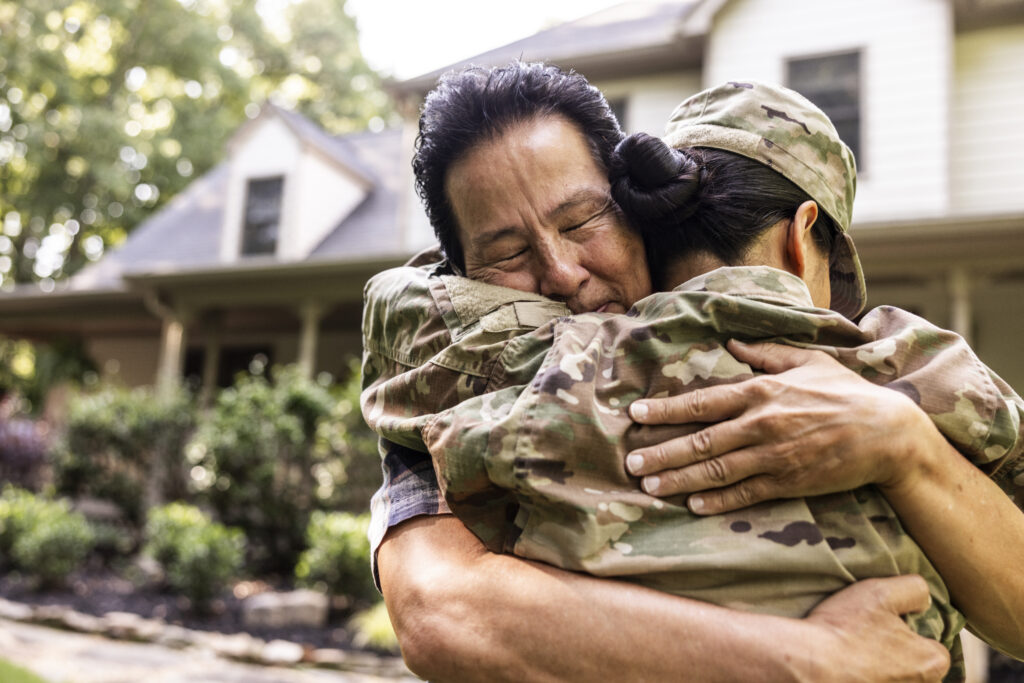Help end stigma and prioritize mental health for veterans and military members

In 2022 there were 16.5 million veterans in the U.S.,1 and their mental health needs are a high priority. It’s essential to address the mental health needs of a veteran through the lens of their personal military experience and their lived experiences, gender, race and age. In addition, a veteran’s own military-affiliated identity should always be respected when discussing mental health.
Using the word “veteran” when identifying someone who served in the armed forces can bring up feelings of pride, sacrifice and resiliency. The word “veteran” may also bring up feelings of guilt, resentment and trauma.
Allowing veterans to share their experiences in a safe and nonjudgmental setting is one of the most effective first steps toward supporting them and their mental health. It’s essential to validate all feelings — even conflicting ones. Sharing resources to help navigate difficult times is an important way to support a veteran’s resiliency and empower them to seek the mental health care they deserve, when needed.
Veteran Crisis Line
24/7 support for veterans and their loved ones
Call 988 — Press 1, text 838255 or chat online.
You don’t have to be enrolled in VA benefits or health care to connect.
Military and mental health facts
One in five people will experience a mental illness each year,2 and they touch all people. This is why it’s so important to normalize the conversation around mental health in the military because just like a physical illness, mental illnesses are treatable health conditions.
More than half (65%) of veterans are currently age 55 or older.3 “Among older U.S. veterans who endured a high number of traumas in their lifetimes, nearly 70% were psychologically resilient in later life,” according to results from the National Health and Resilience in Veterans Study,4 which is encouraging to see. This also indicates promoting prevention efforts such as supporting social connectedness, community integration and purpose in life may help improve resilience and overall mental health with aging veterans.5
Approximately 91% of veterans are men,6 and we know 50% of men are more reluctant to seek mental health care, according to those who responded to the Make It OK IMPACT Survey.7
In 2020 there were over 6,000 veteran suicides (an average of 16.8 per day), and the suicide rate for veterans was 57.3% greater than for non-veteran U.S. adults.9 That said, the suicide rates 2018 to 2020 (age- and sex-adjusted) for veterans fell by 9.7%.9 This overall downward trend follows the VA’s launch of the 2018 National Strategy for Preventing Veteran Suicide, which includes a comprehensive public health approach that combines community and clinical-based suicide prevention strategies and interventions.9
Veteran and military members may face unique barriers to accessing the mental health care they deserve.
-
Not all who served in the military are eligible for VA Benefits.
-
Some veterans see using military-affiliated resources as an extension of their service, which should be considered when discussing resources.
-
A service member may have multiple contributors to their overall mental health that may be related to war zone trauma or other life experiences.
How you can help end the stigma of mental health and illnesses for veterans and military members
Create safe spaces
Creating spaces where individuals can speak without judgment is essential. When veterans feel that their military experience or current stressors are being discussed from a place of genuine concern guided with assistance and resources, they’re much more likely to be honest and open.
Spread awareness
Learn more about mental health, break down myths and normalize that mental illnesses are like any other treatable health condition. Launch Make It OK in your community to spread awareness.
Leaders play a crucial role
Leaders across all branches can set an example by openly discussing mental health and encouraging their troops to use resources at the first sign of stress or symptoms.
Share stories of lived experiences
Sharing real stories of veterans or active duty members who struggled and sought help can help others feel less alone and inspire them to do the same. Find stories of strength and hope at Make the Connection and Personal Lived Experiences.
Media can influence attitudes
Let’s encourage media to portray veterans and active duty military members who manage their mental health positively in movies, TV shows and online. This can help normalize seeking help and shatter stereotypes.
Learn more
- Watch: 15 Things Veterans Want You To Know
- Read: Veterans & Active Duty | NAMI: National Alliance on Mental Illness
- Learn: About mental health conditions such as anxiety, depression, PTSD and more.
- Talk: If a veteran opens up to you about their mental health, actively listen and respond with care. Learn what to say here.
No matter what era or branch that an individual served in, there are resources for all.
Explore more veteran resources
Explore lived experiences
Sources:
- https://www.census.gov/
- https://www.nami.org/mhstats
- National Center for Veterans Analysis and Statistics Profile of Veterans: (2017). (2019). Available online at: https://www.va.gov/vetdata/docs/SpecialReports/Profile_of_Veterans_2017.pdf (accessed July 14, 2020)
- Psychological resilience in older U.S. veterans: results from the national health and resilience in veterans study – PubMed (nih.gov) Pietrzak RH, Cook JM. Psychological resilience in older U.S. veterans: Results from the national health and resilience in veterans study. Depress Anxiety. 2013 May;30(5):432-43. DOI: 10.1002/da.22083. Epub 2013 Mar 6. PMID: 23468170.
- https://www.ncbi.nlm.nih.gov/pmc/articles/PMC7755975/
- Profile_of_Veterans_2017.pdf (va.gov)
- Make It OK IMPACT Survey
- https://www.mentalhealth.va.gov/
- 2022 National Veteran Suicide Prevention Annual Report, VA Suicide Prevention, Office of Mental Health and Suicide Prevention, September 2022